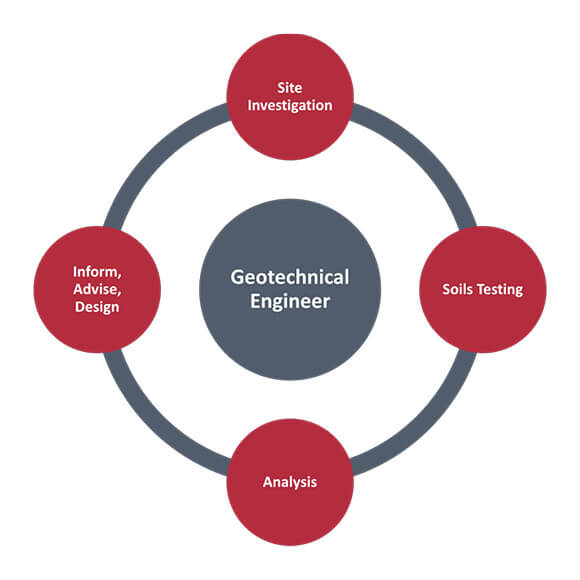Some Of Geotechnical Engineering For Construction Projects
Some Of Geotechnical Engineering For Construction Projects
Blog Article
Not known Facts About Geotechnical Engineering For Construction Projects
Table of ContentsGeotechnical Engineering For Construction Projects - An OverviewThe Of Geotechnical Engineering For Construction ProjectsThe Greatest Guide To Geotechnical Engineering For Construction ProjectsThe Main Principles Of Geotechnical Engineering For Construction Projects Getting The Geotechnical Engineering For Construction Projects To WorkRumored Buzz on Geotechnical Engineering For Construction ProjectsGeotechnical Engineering For Construction Projects Things To Know Before You Buy
Concepts and Technique of Ground Renovation. Ground Enhancement Principles And Applications In Asia. Design evaluation in rock technicians.Cengage Understanding, Stamford, 666 p. Atkinson, J., 2007. The mechanics of soils and foundations. The Observational Technique in ground design concepts and applications.
The smart Trick of Geotechnical Engineering For Construction Projects That Nobody is Discussing
Research laboratory and area testing plays an important function in this procedure. By extracting samples from the planet's subsurface and applying a suite of tests, geotechnical designers can anticipate the behavior of dirt layers and assess their suitability for various building efforts. The essence of geotechnical engineering in civil engineering can not be overemphasized, attributable to numerous variables: The initial step in any kind of geotechnical study includes identifying the dirt type at the building website.
Comprehending these attributes makes sure that just suitable soil kinds are picked for the growth, therefore averting possible architectural failings. The foundation works as the bedrock of any type of construction task. Selecting the suitable structure kind is a decision that depends upon the detailed evaluation offered by geotechnical design. This guarantees the longevity and security of frameworks by fitting the lots they will certainly birth.

Geotechnical site investigation is a vital action in the planning and execution of any building job. It entails the collection and analysis of information associated with the physical buildings of dirt and rock below a recommended building and construction site. This info is crucial for the style and construction of safe, stable, and sustainable frameworks.
The Buzz on Geotechnical Engineering For Construction Projects
In this blog, we will certainly dive right into the value of geotechnical website examination, its various elements, and exactly how it profits construction jobs. Geotechnical site investigation, additionally understood as subsurface expedition, involves a collection of tasks intended at identifying the dirt, rock, and groundwater conditions at a building website. The main purposes are to recognize potential geotechnical dangers, examine the engineering residential properties of subsurface materials, and offer recommendations for the layout and construction of structures, retaining walls, and other frameworks.
The desk research study helps in recognizing potential geotechnical concerns and planning the succeeding fieldwork. This includes observing the topography, drainage patterns, existing frameworks, vegetation, and any kind of indicators of instability or erosion.
Geotechnical Engineering For Construction Projects Fundamentals Explained
Shallow examination pits are excavated to directly observe and example the soil and rock. This technique works for studying the upper layers of see this page the subsurface and identifying near-surface risks. Non-invasive geophysical techniques, such as seismic refraction, ground-penetrating radar (GPR), and electric resistivity tomography (ERT), are utilized to map subsurface problems and detect abnormalities.
Soil and rock examples collected during the area examination are subjected to lab testing to identify their physical and mechanical properties. These examinations supply essential data for geotechnical evaluation and design.
The main benefit of geotechnical site examination is ensuring the safety and security and stability of structures. By understanding the subsurface conditions, designers can create foundations and various other structural components that can withstand the tons and ecological pressures they will certainly undergo. Recommended Reading This lessens the risk of settlement, decrease, and structural failing.
Some Ideas on Geotechnical Engineering For Construction Projects You Need To Know
This guarantees efficient and safe construction practices. Geotechnical website examinations are typically called for by building codes and guidelines.
This details is invaluable for project supervisors, engineers, and specialists in creating practical timetables, budgets, and backup plans. Geotechnical Engineering for Construction Projects. Skyscraper in a Coastal AreaIn a seaside city, a high-rise domestic building was intended on a website with suspected loosened sand down payments and a high water table. An in-depth geotechnical investigation, including borehole boring, CPT, and geophysical studies, was carried out
Geotechnical Engineering For Construction Projects Can Be Fun For Anyone
Based on these searchings for, the foundation design was modified to consist of deep heap structures extending right into secure strata, and ground improvement techniques, such as vibro-compaction, were applied to reduce liquefaction dangers. This positive strategy made certain the safety and stability of the structure while avoiding costly post-construction remediation. Facilities Growth on a Sloping TerrainA significant infrastructure project, involving the construction of a highway and bridges, was prepared on a sloping surface with high slopes.

The Leaning Tower of Pisa (Italy), a renowned building wonder, is well known for its unexpected tilt from substantial geotechnical concerns. The tower's foundation was inadequately developed to manage the soft, unsteady soil below it, resulting in uneven settlement and its go to the website distinctive lean. Our globe is populated with excellent infrastructure projectsfrom towering skyscrapers to stretching bridgesall standing testimony to the development of the different building and construction equipment and techniques offered.
Geotechnical engineering is a customized area within civil design that concentrates on examining the habits of earth products. This branch dives deep into the groundinvestigating just how the soil, rock, and groundwater at a building site can influenceand be influenced bythe framework that we set up on and into them. Prior to a solitary block is laid or a concrete structure put, geotechnical designers probe right into the earthgathering crucial information about the website's dirt composition, rock framework, and groundwater levels.
Things about Geotechnical Engineering For Construction Projects

is a device made use of to assess the stability and load-bearing capacity of stacks during installment, leveraging the principle of wave proliferation. It maximizes construction effectiveness by giving real-time assessments, hence guaranteeing secure and efficient heap structures. One of the useful applications of geotechnical design includes determining and carrying out the right approaches for structure building and construction.
Load driving represents greater than the mere act of putting architectural components right into the ground. However, it is a carefully orchestrated procedure of transferring a framework's tons past the less secure soil layers more detailed to the surfacedown to the a lot more considerable strata that lie under. When it comes to heap driving, consider how geotechnical engineers expertly use this technique to uniformly disperse the framework's weight.
Report this page